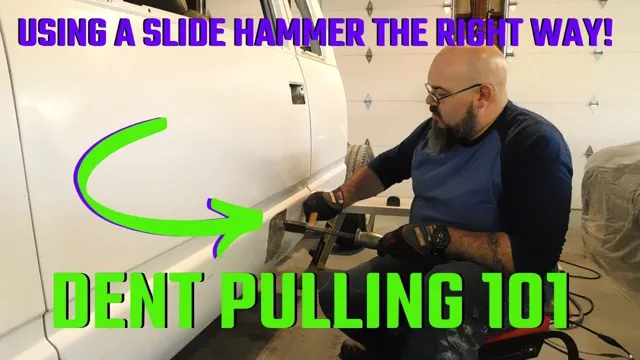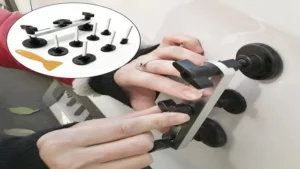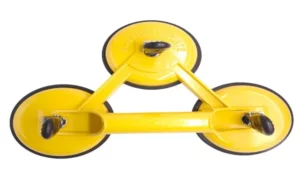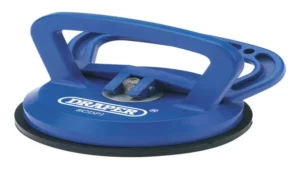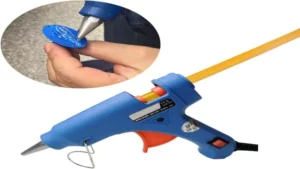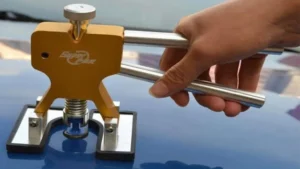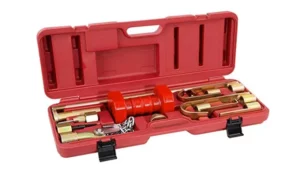Dents on a car can be frustrating, especially when they ruin the appearance of your vehicle. In the past, repairing car dents meant costly visits to a body shop and long wait times for repairs. However, technology has advanced, and the use of a dent puller has made it easier for car owners to fix dents themselves.
A dent puller is a tool that removes dents from car body panels. It works by suctioning onto the dent, and after pulling, it releases the dent and leaves the surface smooth. This tool is straightforward to use, and it doesn’t require any special skills or knowledge.
With the help of a dent puller, you can now keep your car looking like new without spending a fortune. You can significantly improve the resale value of your car by dealing with dents as soon as possible. Do you have a car with dents that you’ve been avoiding repairing? With a dent puller, you can take matters into your own hands and fix them yourself.
Stay tuned to learn more about removing dents with a dent puller and how to use one effectively.
What You’ll Need
If you’ve never tried removing a dent with a dent puller before, you may be wondering what tools you will need to get the job done. The good news is that the process is relatively simple and requires only a few necessary items. To begin with, you’ll need a quality dent puller, which can be purchased online or at your local auto repair shop.
You’ll also need a drill, sandpaper, and a cleaning cloth to remove any debris from the surface of the dent. Additionally, you’ll want to have a heat gun or hairdryer on hand to warm up the metal and increase its flexibility before you begin pulling the dent out. Finally, it’s always a good idea to wear protective gloves and goggles to keep your hands and eyes safe as you work on your vehicle.
With these items at the ready, you’ll be well on your way to restoring your car’s appearance without the need for professional assistance.
Dent puller kit
If you have a vehicle with minor dents and dings, a dent puller kit can be a lifesaver. These kits provide a cost-effective way of removing small dents from your car’s bodywork without having to take it to a professional repair shop. So, what do you need to use one of these kits? Firstly, you’ll need a dent puller itself.
This tool will be the workhorse of the kit and will allow you to remove the dent from your car’s bodywork. Secondly, you’ll need a set of adapters. These are essential as they will allow you to use the kit on various sizes of dents.
Finally, you’ll need a series of knockdowns and hammers. These will provide you with the necessary force to push the dent out and reshape your car’s bodywork. With these tools in hand and the right technique, you can take on car dents without breaking the bank, all while gaining a new skill in the process.
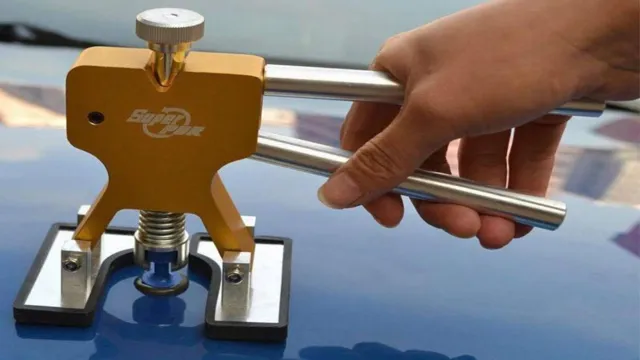
Clean cloth
Keeping clean cloths around the house is essential for maintaining hygiene, and there are many things you can do with them. To start, you’ll need a few things: good quality cloths, a washing machine, and some good detergent. Good quality cloths can be found in a variety of stores, and you want to get ones that are absorbent, durable, and easy to clean.
A washing machine is essential for cleaning your cloths since they accumulate dirt and grime quickly. Using a good detergent is also important for maintaining the quality of your cloths and keeping them fresh and clean. You can also use clean cloths for a range of household chores such as wiping down surfaces, mopping up spills, and dusting.
Make sure to keep them organized and separate from dirty ones to maintain a clean and healthy living environment. Overall, keeping a supply of clean cloths is a simple yet effective habit that can improve your home’s cleanliness and promote better hygiene.
Hair dryer or heat gun
When it comes to styling your hair, having the right tools is crucial for achieving the look you want. Whether you’re blowdrying or heat styling, you’ll need a tool that can efficiently and safely apply heat to your hair. Two popular options are a hair dryer and a heat gun.
A hair dryer is a common household tool that uses heated air to dry and style hair, while a heat gun is typically used in industrial settings and produces a more intense blast of heat. While both tools can be effective for styling, it’s important to choose the right one for your hair type and styling needs. For example, if you have thin or fine hair, a hair dryer may be a better option as it can provide a more gentle heat and less damage to your hair.
On the other hand, if you have thick or curly hair, a heat gun may be more effective as it can provide a more intense heat to help smooth and straighten your hair. Ultimately, the choice between a hair dryer and a heat gun will depend on your hair type and preferred styling technique. By understanding the differences between these two tools, you’ll be able to choose the right one to achieve the perfect hairstyle.
Rubbing alcohol
Rubbing alcohol is a versatile household item that can be used for a variety of purposes. To get started, you’ll need some rubbing alcohol, which can be found in most drugstores or grocery stores. The most common type available is isopropyl alcohol, which is a clear liquid that is typically sold in bottles of 70% or 91% strength.
You’ll also need a clean cloth or cotton ball, as well as some gloves to protect your hands from the alcohol. If you plan on using the rubbing alcohol for cleaning, you may also want to have a spray bottle on hand. Once you have these items, you’re ready to start taking advantage of the many benefits of rubbing alcohol.
Whether you’re using it to disinfect surfaces or remove stubborn stains, rubbing alcohol is a must-have item for any household.
Preparing the Surface
When it comes to removing a dent on your car’s surface with a dent puller, the first step is to prepare the surface. The surface needs to be clean and dry to ensure that the dent puller can stick properly. Use a soap and water solution to clean the dent and surrounding areas thoroughly.
Then, dry it with a clean towel or cloth. Use rubbing alcohol to remove any remaining dirt or wax. Once the surface is clean, apply a generous amount of glue to the suction cup of the dent puller, making sure to cover the entire cup evenly.
Place the suction cup onto the center of the dent and press it firmly against the surface. Now the surface is ready for the repair process to begin. By following these steps, you can ensure that the dent puller will attach properly and work efficiently to remove the dent from your car’s surface.
Clean the area with rubbing alcohol
Before starting any project that requires applying adhesives or stickers, it’s important to prepare the surface by cleaning it thoroughly. One effective way to do this is by using rubbing alcohol. This will remove any dirt, grease, or other residue that may have accumulated on the surface and ensure that the adhesive will stick properly.
Rubbing alcohol is a common ingredient in many cleaning solutions because it evaporates quickly and doesn’t leave any residue behind. It’s important to use a clean cloth or cotton ball and to apply the rubbing alcohol evenly over the entire surface. Afterward, allow some time for the area to dry completely before applying any adhesives or stickers.
By taking the time to properly prepare the surface, you can ensure that the adhesive will stick well and that your project will look neat and professional. So, next time you start a project involving adhesives, make sure to grab some rubbing alcohol and give the surface a good cleaning!
Warm the dent with a hair dryer or heat gun
To properly prepare the surface of a dent before repairing it, it’s important to warm up the affected area to make it more pliable and easier to work with. You can do this by using a hair dryer or heat gun to gently warm up the metal. Be careful not to overheat the area, as this can cause the paint to bubble or crack.
Once the surface is adequately warmed up, you can begin to massage the dent back into shape, either using your hands or with the help of specialized tools. Remember to take your time and work carefully so as not to cause any further damage to the surface of the vehicle. By properly preparing the surface of the dent, you’ll be well on your way to achieving a flawless repair.
So, take your time, warm it up, and get ready to work your magic!
Using the Dent Puller
Removing a dent from your car can be a tricky task, but using a dent puller can make it easier. The first step is to identify the dent and determine if it is shallow enough to be pulled out. Once you have confirmed this, clean the area around the dent to ensure that there is no dirt or debris that may interfere with the suction cup’s ability to stick to the car’s surface.
Next, place the dent puller over the dent and apply pressure by pulling the handle towards you. The suction will create a vacuum-like pressure, which will gradually pull out the dent. Repeat this process until the dent is fully removed, and don’t forget to remove the dent puller carefully.
With a little patience and the help of a dent puller, you can easily fix the dents on your vehicle without having to spend a lot of money on repairs.
Attach the suction cup to the dent
When it comes to fixing dents on your car, a suction dent puller could be a great tool to use. Start by cleaning the dent area thoroughly. Then, place the suction cup onto the center of the dent and push it down firmly.
This creates a vacuum seal that holds the suction cup in place, making it easier to pull the dent. Pull the suction cup slowly and steadily outward, using all of your strength to lift the dent. Keep pulling until the dent pops back into place.
This process may take a few tries, but don’t give up! With a little patience and effort, your car will look as good as new. So, don’t let that unsightly dent bring you down. Grab a suction dent puller and start fixing it today!
Using firm pressure, pull the dent out
The Dent Puller tool is an effective and efficient way to repair minor dents on your car’s body. Using the Dent Puller is straightforward. First, identify the dent and clean the area around it.
Once you’ve done that, place the suction cup of the Dent Puller on top of the dent and press it down firmly onto the surface. Then, use the handle to pull the dent out. The suction from the Dent Puller will help create a vacuum, pulling the dent out with ease.
It’s important to use firm pressure when pulling the dent out to ensure the suction cup doesn’t slip. Once the dent is out, use a touch-up paint to cover any remaining scratches or marks. The Dent Puller tool is a cost-effective alternative to expensive car repairs, and with just a little effort and time, you can remove unsightly dents without leaving your home.
Reposition the suction cup and repeat if needed
When using a dent puller, the suction cup may not grip the surface properly the first time around. Don’t worry; this is a common issue that can be easily fixed. Reposition the suction cup and repeat the process until you achieve a tight and secure grip.
It’s essential to ensure that the suction cup is in the correct position before pulling on the dent to avoid damaging the surrounding area. If you’re having trouble getting the suction cup to stick, try cleaning the area first or applying a little bit of moisture to improve the suction. Remember to be patient and take your time to make sure you get the desired results.
By following these steps, you can easily use the dent puller to remove unsightly dents from your car without having to pay for professional services.
Finishing up
To finish up this process of removing a dent with a dent puller, all that’s left is to clean up any remaining residue. After removing the glue tabs and cleaning off the glue, inspect the area for any remaining damage. If the dent has not fully been removed, you may need to repeat this process or consider seeking professional help.
If the dent is fully removed, take a step back and admire your work! It’s always a great feeling to successfully repair something on your own. Remember to store your dent puller kit in a safe place for future use. Overall, using a dent puller to remove dents is a cost-effective and simple solution for minor car damage.
With just a few steps, you can save money on repairs and have your car looking as good as new in no time.
Clean the area with a clean cloth
Once you have finished cleaning the area thoroughly, it’s time to give it a final wipe down with a clean cloth. This will ensure that there are no leftover streaks or dirt on the surfaces, leaving the area looking sparkling clean. Make sure to use a cloth that is clean and dry, as any moisture could leave behind watermarks or streaks.
Using a microfiber cloth is a great option, as it is gentle on surfaces and effectively picks up any remaining dust or debris. Gently wipe down any surfaces in the area, including counters, tables, and appliances. Take your time, making sure that you don’t miss any corners or crevices.
Once you are finished, step back and admire your work – the space should now be looking refreshed and new!
Use touch-up paint to conceal any damage
When it comes to finishing up your DIY paint job, it’s important to pay attention to the little details. One of those details is using touch-up paint to conceal any damage. Whether it’s a small scratch or a chip, using touch-up paint can help to make your paint job look seamless and professional.
It’s important to choose a touch-up paint that matches your original paint color closely to avoid a noticeable difference in shades. Applying the touch-up paint is simple – just use a small brush or applicator to fill in the damaged area, and allow it to dry completely. By taking the time to use touch-up paint, you can ensure that your paint job looks its best and stands up to wear and tear over time.
So go ahead and add those finishing touches, your hard work will be worth it in the end!
Test drive the car to ensure the dent is fully removed
Now that the dent repair is complete, the last step is to take the car for a test drive to ensure that the dent has been fully removed. It’s essential to make sure that the car’s body is free of any damage before taking it out on the road. While driving, check to see if there are any visible signs of a dent or if there is any unusual noise or vibrations.
If everything seems okay, then you can be confident that the dent has been successfully removed. It’s always better to be safe than sorry, especially when it comes to your vehicle. So, take the time to test drive the car and ensure that everything is in top condition.
Overall, with the proper professional dent repair, your vehicle will look brand new again, and you can drive with peace of mind.
Conclusion
In conclusion, removing a dent with a dent puller is like playing a game of reverse Jenga – instead of stacking blocks, you strategically pull until the dent is no more. Just remember to be patient, use the right tools, and don’t get too overconfident with your pulling skills. With a little bit of elbow grease and a lot of determination, that pesky dent will soon be a distant memory.
Happy pulling!”
FAQs
1. What is a dent puller and how does it work for dent removal?
A dent puller is a tool used for removing dents from a car’s body. It works by pulling the dent out using suction or leverage.
2. Can any dent be removed using a dent puller?
No, not all dents can be removed using a dent puller. It’s best suited for small to medium-sized dents and works well on flat surfaces.
3. Is it necessary to have professional experience to use a dent puller?
No, using a dent puller is simple and can be done by anyone. However, it’s important to follow the instructions carefully to avoid damaging the car’s paint.
4. What are the types of dent pullers available in the market?
There are several types of dent pullers available, including suction cup dent pullers, slide hammer dent pullers, and glue pullers.
5. Can a dent puller remove dents from all types of car materials?
No, a dent puller is most effective on metal car bodies. It may not work on plastic or fiberglass materials.
6. Can a dent puller be used on deep dents or scratches?
No, a dent puller cannot be used on deep dents and scratches. It’s best suited for surface-level dents only.
7. Is it necessary to use a dent puller to remove dents or are there other alternatives?
There are other alternatives to remove dents, such as using a plunger or dry ice. However, these methods may not be as effective as using a dent puller.
